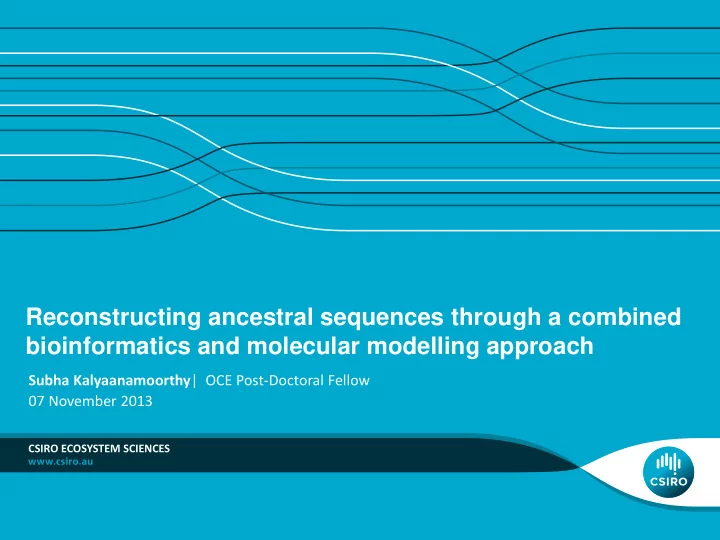

Reconstructing ancestral sequences through a combined bioinformatics and molecular modelling approach Subha Kalyaanamoorthy | OCE Post-Doctoral Fellow 07 November 2013 CSIRO ECOSYSTEM SCIENCES
Ancestral Sequence Reconstruction • A rearward approach that uses the evolutionary relationships between the extant sequences to infer their common ancestral state, which no longer exists in earth • Replaying the evolutionary trajectory to trace the molecular trials through which the present day sequences have evolved has now become possible through phylogenomic approaches 2 | Ancestral Sequence Reconstruction | Subha Kalyaanamoorthy
Why ASR? Applications of ASR Image Source: Manuscript in preparation 3 | Ancestral Sequence Reconstruction | Subha Kalyaanamoorthy
Current ASR projects • We are reconstructing the ancestral states of biologically and/or industrially useful enzymes, including hydrolases and oxidoreductases , in order to understand their evolutionary process and engineer them for various ‘present - day’ applications.. • Phylogenetic methods and advanced molecular modelling approaches, in corroboration with experiments, are employed in the reconstruction 4 | Ancestral Sequence Reconstruction | Subha Kalyaanamoorthy
Protocol • Approximately 60 extant sequences from different insect species were collected from various sources and aligned • The alignments are visually assessed and their completeness were analysed using Alistat • The extant sequences were verified if they have evolved under stationary conditions using Homo. • The best-fitting evolutionary model was selected and the phylogenetic tree was constructed. • Given the tree and the evolutionary model, the ancestral states were estimated using maximum likelihood methods 5 | Ancestral Sequence Reconstruction | Subha Kalyaanamoorthy
Maximum Likelihood • The ML method calculates the ancestral character state based on the likelihood scores (i.e., the probability that the extant sequences would evolve from the inferred ancestral state), given a phylogenetic tree and an explicit stochastic model to describe the evolution. • Two types of methods: Joint and Marginal reconstruction 6 | Ancestral Sequence Reconstruction | Subha Kalyaanamoorthy
Joint and Marginal Joint: Identifies the most probable set of character states for all internal nodes at any given site, resulting in the maximum joint x 6 ? likelihood of the tree Pr (x 1-6 |D, θ )= Pr (x 1-6 |D, θ ) Pr (D, θ ) x 2 ? x 5 ? x? x 1 ? x 4 ? x 3 ? A L V V A M A Marginal: Identifies the most probable character state for a particular site of the tree, by comparing the likelihoods of different character states at the given site Pr (x|D, θ )= Pr (x|D, θ ) Pr (D, θ ) 7 | Ancestral Sequence Reconstruction | Subha Kalyaanamoorthy
Reconstructed ancestral states Molecular modelling and dynamics-based screening!!! In-vitro resurrection 8 | Ancestral Sequence Reconstruction | Subha Kalyaanamoorthy
9 | Ancestral Sequence Reconstruction | Subha Kalyaanamoorthy
Model quality assessment X-ray crystal structure Threading model Homology model 10 | Ancestral Sequence Reconstruction | Subha Kalyaanamoorthy
Superimposed ancestral model and extant homologue (crystal structure) 11 | Ancestral Sequence Reconstruction | Subha Kalyaanamoorthy
Molecular dynamics • Molecular dynamics (MD) is a computational biophysics approach to study the equilibrium structure, stability, dynamic and transport properties of bio-molecules, such as proteins • MD offers significant insights into the time- and temperature- dependent fluctuations and conformational changes in biological systems, which are useful to understand their physical and functional features • We employ classical (molecular mechanics based) approaches, as implemented in NAMD, to study the effects of amino acid substitution in the dynamic behavior of the ancestral enzymes at physiological temperature and pressure 12 | Ancestral Sequence Reconstruction | Subha Kalyaanamoorthy
Root Mean Square Deviation 13 | Ancestral Sequence Reconstruction | Subha Kalyaanamoorthy
Free Energy Perturbation Free energy perturbation (FEP) is a computational chemistry method for calculating the relative free energy difference for two states From the thermodynamic cycle, the folding free energy difference ΔΔ G = Δ G 3 - Δ G 2 between the wild-type protein and the mutant can be calculated via Δ G 1 –Δ G 4 The more positive the ΔΔ G , the more the mutant is destabilized in comparison to the wild type 14 | Ancestral Sequence Reconstruction | Subha Kalyaanamoorthy
For ‘n’ positions with different reconstructions -- we could expect 2 n ancestral sequence combinations Mutated ΔΔ Stability ΔΔ Stability ΔΔ Prime Preference : Residue Original (gas) (solvated) energy (1) T51-K229-R306 A:51 THR SER 2.05 0.84 4.2 (2) T51-E229-R306 A:51 SER THR -6.01 -1.23 -4.59 A:229 GLU LYS 69.83 -0.55 -2.47 A:229 LYS GLU 125.83 3.61 14.31 A:306 ARG SER 25.56 11.59 41.37 A:306 SER ARG 192.22 -2.65 -32.42 Similar procedures were repeated for the ancestral sequences constructed for the other node, which produced different reconstruction in 7 positions Our preliminary one-to-one substitution analysis resulted in three preferred sequences out of the 7, which has significant impact to subsequent experimental costs and time 15 | Ancestral Sequence Reconstruction | Subha Kalyaanamoorthy
Summary • Studies on the molecular trails and the characteristics of the desired ancestral character states provide enormous insights into the evolutionary relationships between the extant and extinct • Preliminary results presented here serve as a good example of how different computational methods for bioinformatics, phylogenomics and molecular modeling and dynamics can combine to play an increasingly relevant role in resurrecting ancestral character states with minimum cost and time. • Last but not the least, it should be acknowledged that Discovering the past becomes a valuable key for Inventions of ‘The Future’ 16 | Ancestral Sequence Reconstruction | Subha Kalyaanamoorthy
Thank you Bioinformatics & Phylogenomics Team Subha Kalyaanamoorthy OCE Post-Doctoral Fellow t +61 2 6246 4522 e subha.kalyaanamoorthy@csiro.au CSIRO ECOSYSTEM SCIENCES
Recommend
More recommend